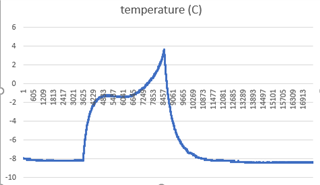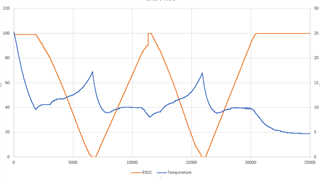Other Parts Discussed in Thread: GPCRB
Hi,
Customer is doing cyclic charge and discharge test. and found 91% to100% jump at charging and 2% to 0 jump at discharging. Please help to analyze the reason of this jump. they've done GPCRB. thanks.
This thread has been locked.
If you have a related question, please click the "Ask a related question" button in the top right corner. The newly created question will be automatically linked to this question.
Hi,
Customer is doing cyclic charge and discharge test. and found 91% to100% jump at charging and 2% to 0 jump at discharging. Please help to analyze the reason of this jump. they've done GPCRB. thanks.
Hello,
Looking at the GPCRB files, the room temperature and low temperature data had a jump more than 5C in temperature. This affects the GPCRB calculations and accuracy. There are chances that the report is not accurate due to unstable temperature while data collection. Please see below. 

Also, is the customer constantly changing the temperature on purpose? The impedance track algorithm highly depends on temperature. Any big change in temperature affects the gauge's prediction.
Regards,
Jose Couso
Jose,
5℃ temperature rise is normal. battery will heat during charging. They used 1C to discharge at room temp and 0.35C at low temperature. so What's your suggest to avoid this? commonly, what's the recommended discharging current for GPCRB? thanks.
Hello Yue,
Yes, 5℃ temperature rise is normal and the gauge can handle it, but as seen above there's a change in temperature of 15℃. I suggest the customer use a temperature chamber to run the test.
what's the recommended discharging current for GPCRB? thanks.
Depends on the Chemistry, but usually from C/10 to C/5. If it's LFP chemistry, please ensure to wait 24 hours after charge.
Please reference to section 3 in the guide below:
https://www.ti.com/lit/an/slva725a/slva725a.pdf?ts=1668093351794&ref_url=https%253A%252F%252Fwww.ti.com%252Ftool%252FGPCCHEM
Regards,
Jose Couso